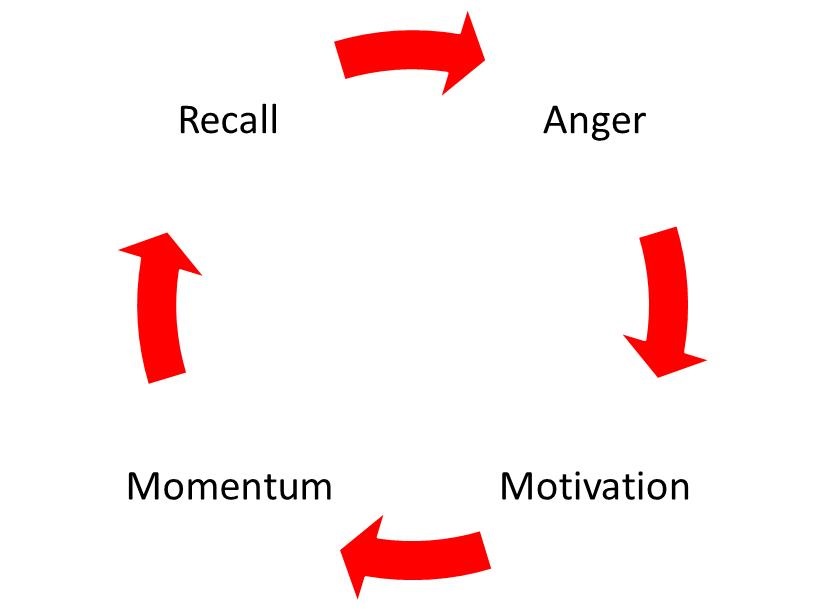Byron Barrett photo
By
Siddhartha Rastogi
The general belief about Anger is that it is negative
Preachers, great thinkers time and again have spoken about the ill effects of anger and how it can be self-destructive. Researches have shown that angry people have 10 times more propensity to collapse of cardiac arrest than less angry ones. Tests and experiments have concluded that the top quartile of angry men and women have a 1.57 times higher risk of dying than the ones who are less angry. Scientifically and biologically speaking, when a person gets angry, arteries constrict, blood pressure rises and the heart rate goes up. This can be fatal.
What we don’t know about Anger
Anger as against all popular beliefs can be the biggest motivational force for one to achieve his or her goals.
When you get angry, the heart rate, arterial tension and testosterone production increase, cortisol – the stress hormone – decreases, and the left hemisphere of the brain becomes more stimulated. To give you the right perspective, the left hemisphere of your brain is dominant with language, processing what you hear and speak, carrying logic, mathematical computation and your memory. When the left portion of your brain gets stimulated, two things can potentially happen.
1 – You tend to get closer to the reason of your anger and figure out ways to eliminate it completely;
2 – You tend to get more focused to achieve the thing, the lack of which has caused anger.
In both conditions, anger turns into a great motivating force, which leaves you at the centre of a situation which you try and desperately solve. With extreme focus on the subject, the peripheral thoughts vanish and the brain starts working on possibilities using data of your entire past experiences which your conscious mind might have forgotten.
As possible solutions start originating, plans for the future along with the next steps are visualized by your brain.
Anger also brings empathy as it puts you right in the middle of the circumstances which others have gone through and you were indifferent to it to date. Words and feelings which were ignored by you from the person who was in your position earlier come back to life and you start engaging with others who are in the similar situation or who have gone through it in the past.
So much has been said on the viciousness and benefit of anger. But the complication lies in constructively holding onto the emotion and executing the steps which have been hatched or originated with great precision.
Most individuals lose the steam or energy by talking and cribbing about what happened in the past in that moment of no return. Once the instance of anger fizzles out, it takes away the energy and shifts the focal point of another situation or problem in hand. People repeatedly find themselves in a similar state, get angry and move on in life, and existence keeps chugging along.
The trick here is to see what upsets and creates anger in you and then to figure out whether it can be that source of power which aids you to achieve your unachievable thought or goal. All humans have a hidden desire to do things, to do more with their life, to reach their utmost potential, to execute deeds which they believe can bring solace and happiness. This destination is so important that after successfully reaching that desired point, one feels or at least believes will feel proud and satiated.
If you are able to link anger with your ultimate objective, non-achievement of which will keep pricking you, force yourself to take concrete steps towards your target and this feeling can drive you to move rapidly, then anger turns into the driving force, leading to action and finally momentum.
Let me explain this using 2 examples.
Chankya, the greatest strategist and Guru India has ever produced, untied his Shikha (tuft of hair) as a reminder of the insult from Dhana Nanda, the last king of Nanda empire. This happened when Chanakya went up to him to seek help against the aggression from Alexander and protect India from Greek invasion. The untied tuft kept reminding him of his ultimate goal of unifying India under one flag which happened under the Mauryan Empire. Without the insult and open tuft, perhaps Chanakya and Chandra Gupt Maurya will have never reached their destiny and would have forgotten the cause in their day-to-day affairs.
In the great epic Mahabharata, Draupadi after being disrobed by Dushashan, swore to only tie her hair after she washed it with the blood from Dushashan’s heart. Whenever Pandavas saw Draupadi’s open hair, it reminded of her determination to execute the perpetrator.
A symbol of anger which one carries on himself or herself keeps reminding of the condition and circumstances, refreshing and rebooting the memory every time the brain and heart gets entangled forgets about the incident.
Once the ideas move into concrete action and thoughts start taking shape, one experiences initial resistance. This is the toughest time, where the brain resists the change and disguises one’s belief that execution of ideas is impossible as it’s not part of routine. Symbols like the ones mentioned above reminds you again of the atrocity / injustice or any other event, making you resist complacency to move ahead.
Once the action is taken, repeated enforcement after the resistance brings like-minded forces together and momentum gathers. Once momentum seeps in, results are guaranteed.
Hence the Anagogic banker says, “build your anger in bit by bit and you can move a mountain.”
Siddhartha Rastogi
Siddhartha was born to a learned middle class educated family in Semi Urban India. His father was an extremely honest man who because of his honesty had to pay the price in corporate world. Mother is a determined woman who ensured that children are being well taken care off. After a few years of birth, doctors called Siddhartha, a slow child having flat foot. He would fall more than he could walk. Determined mother ensured all therapies for her son to come out strong to fight the world. Siddhartha joined swimming when he was in 6th standard. Seeing other children of his class, he jumped in 10 feet deep pool and learnt swimming on his own, the very same day.
From that day there was no looking back. He topped his city in 12th and went to score highest in his B school exams. During his profession as banker, he became youngest branch manager of a MNC bank managing their biggest wealth branch in the country. There he found love of his life and got married. His love of his life emerged in the form of his daughter who completely changed him for good.
Siddhartha Rastogi is Director for a boutique Investment bank in India.
Siddhartha is a forward looking thinker & writer who has written a book on decision making. 8 Simple steps to effective decision making.
He writes on various social and current issues via his blog and can also be found on twitter.




No Comments Yet!
You can be first to comment this post!